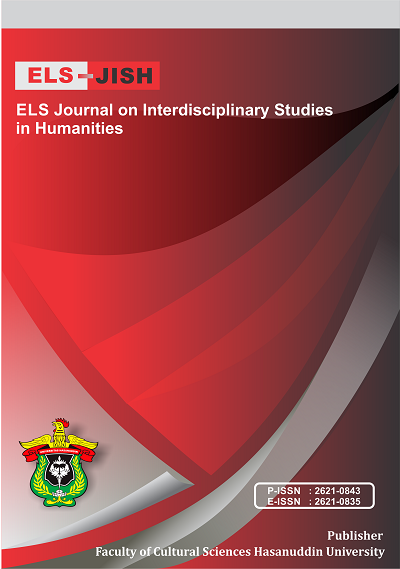An Analysis of Lexical Collocation in King Charles’ Speech
DOI:
https://doi.org/10.34050/elsjish.v6i2.26833Keywords:
Lexical Collocation, King Charles, SpeechAbstract
Collocation is quite common to every native speaker. English language is restricted to collocation. It has set its own patterns that occur in natural way. Collocation takes in the form of lexical combination and grammatical combination. Respecting to King Charles III, he starts to deliver speeches on numerous occasion after becoming new monarch. The usage of collocation might differ widely from deeper meaning and context behind. This qualitative research is designed to analyze lexical collocation that exists in King Charles’ speech. The document obtained from speech text was published by website ‘PBS News Hour’. The research results points out that 15 collocation data were produced by King Charles III in his speech. It clearly reflects how he conveyed some collocation form to exact meaning. Those were accepted in its language system, culture, and real life. This research is expected to bring out the best in foreign students’ language proficiency, understanding other language system and culture differences.
References
Andini, C., Sosrohadi, S., Fairuz, F., Dalyan, M., Rahman, F. F., & Hasnia, H. (2022). The Study of Japanese Women in the Facial Treatment Advertisement: A Semiotics Perspective of Pierce’s Theory. ELS Journal on Interdisciplinary Studies in Humanities, 5(2), 337-347.
Andini, C., Yassi, A. H., & Sukmawaty. (2021). The Use of Honorifics in English and Buginese with special Reference to Bone Language: A Comparative Study. International Journal of Innovative Science and Research Technology, 6(7), 873-877.
Aswad, M., Rahman, F., Said, I. M., Hamuddin, B., & Nurchalis, N. F. (2019). A software to increase English learning outcomes: An acceleration model of English as the second language. The Asian EFL Journal, 26(6.2), 157.
Benson, M., Benson, E., & Ilson, R. (1986). The BBI combinatory dictionary of English. Philadelphia: John Benjamins Publishing Company.
Cai, Y. (2017). Second language acquisition of chinese verb-noun collocations. Amherst: University of Massachusetts.
Farida, S. (2018). An Analysis of English Collocation in Jenny Han’S Novel “Ps I Still Love You” (Doctoral dissertation, University of Muhammadiyah Malang).
Gao, X. (2016). A cross-disciplinary corpus-based study on English and Chinese native speakers' use of linking adverbials in academic writing. Journal of English for Academic Purposes, 24, 14-28.
Gayatri, B. (2018). An Analysis of Collocation in Hillary Clinton’s Speech (Doctoral dissertation, Universitas Sumatera Utara).
Halliday, M. A., & Hasan, R. (1976). Cohesion in English. London: Longman Group.
Hasnia, H., Andini, C., Tahir, M. D., Hunaeni, H., Zulfikariandi, Z., & Muslimin, M. T. (2022). The Ability of 1st Class Students of SMAN 11 Enrekang to Arrange Verbal and Nominal Sentences. ELS Journal on Interdisciplinary Studies in Humanities, 5(3), 539-550.
Hudcovičová, M., Jančovičová, Ľ., Petrášová, B., & Baghana, J. (2021). The English grammatical collocations of the verb and the preposition for and their collocational equivalents in the Slovak language. Linguistics and Culture Review, 5(S1), 1183-1194.
Kimmes, A., & Koopman, H. (2011). Collocation-Analyzer: an Electronic Tool for Collocation Retrieval and Verification. Available on August 2022: http://www. t21n. com/homepage/articles/T21N-2010-11-immes, Koopman. pdf (дата звернення: 1.08. 2018).
Lea, D., Dignen, S., & Crowther, J. (2002). Oxford collocations dictionary for students of English. New York: Oxford University Press.
Lestari, A. P. (2019). An analysis of collocation used by the main character in the Hidden Figures movie (Doctoral dissertation, University of Muhammadiyah Malang).
Pisitsenakul, S., & Khamnok, W. (2019). The use of grammatical collocations with prepositions and attitude towards collocations learning of Thai EFL undergraduate students. Rangsit Journal of Educational Studies, 6(1), 51-64.
Prihandoko, L. A., Tembang, Y., Marpaung, D. N., & Rahman, F. (2019). English language competence for tourism sector in supporting socio-economic development in Merauke: A Survey Study. In IOP Conference Series: Earth and Environmental Science (Vol. 343, No. 1, p. 012170). IOP Publishing.
Rahman, F. (2018). The Constraints of Foreign Learners in Reading English Literary Works: A Case Study at Hasanuddin University. Journal of Arts and Humanities, 7(2), 01-12.
Rahman, F., & Weda, S. (2019). Linguistic deviation and the rhetoric figures in Shakespeare’s selected plays. XLinguage" European Scientific Language Journal", 12(1), 37-52.
Shabani, G., & Rahimy, R. (2020). An investigation of the effectiveness of enhancing input through glossing and skewing techniques on knowledge of lexical collocation. Journal of Psycholinguistics Research, 49, 1011-1025.
Sukmawaty, Rahman. F. F., & Andini, C. (2022). Covid-19 Pandemic and Axiology of Communication: A Study of Linguistic Phenomena. IJISRT, 7(4), 1079-1087.
Downloads
Published
How to Cite
Issue
Section
License
Copyright (c) 2023 Siti Rachmi, Abdul Hakim Yassi, Sukmawaty

This work is licensed under a Creative Commons Attribution-ShareAlike 4.0 International License.






